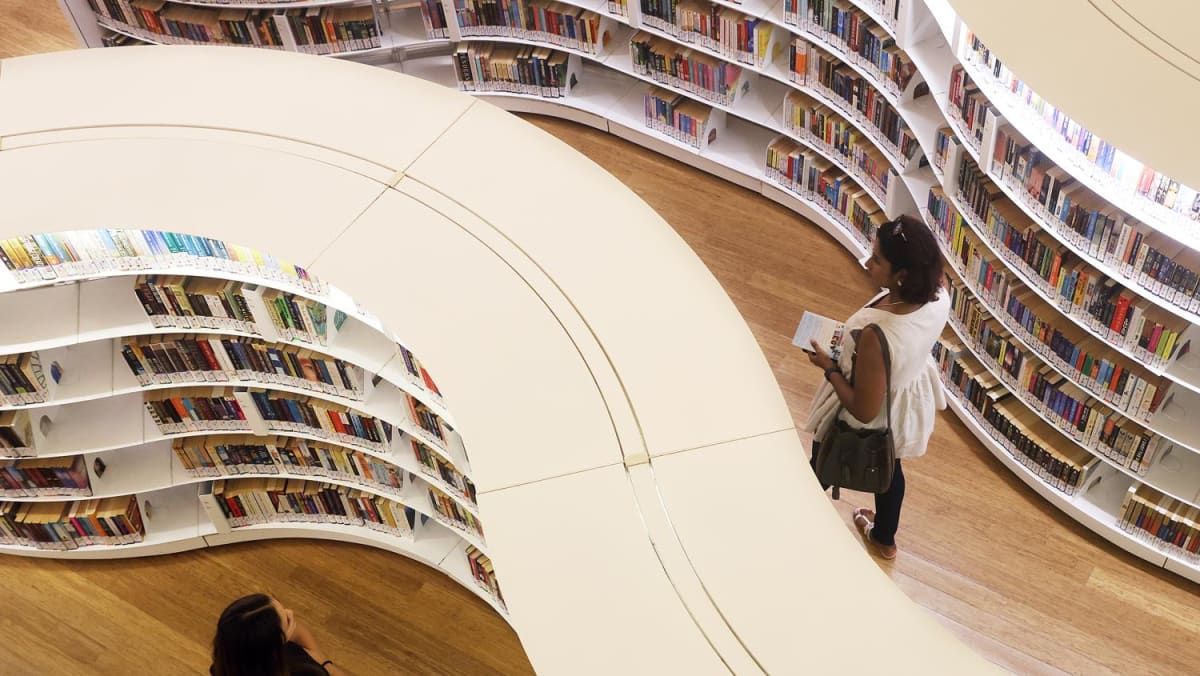
Each week, TODAY’s long-running Big Read series delves into the trends and issues that matter. This week, we look at how Singapore’s public libraries have evolved amid the digitalisation wave, bucking the trend of falling visitorship and closures seen in some other countries. This is a shortened version of the full feature, which can be found here.
While public libraries in some countries are facing dwindling visitorship, funding cuts and copyrights tussles amid the digitalisation wave, those in Singapore have escaped the same fateOn the contrary, public libraries here are seeing increased number of visitors and plans are afoot to continuously rejuvenate and expand existing libraries; the five-storey Punggol Regional Library also opened its doors in April 2023 According to users whom TODAY spoke to, libraries here have managed to adapt to their users’ evolving needsApart from shifting their services online, libraries have also redesigned their physical spaces to go beyond being mainly repositories of booksSuch moves — including opening a new Children’s Biodiversity Library in January next year — are also seen as important to attract young users and cultivate a love for reading and learning
SINGAPORE — At the Queenstown Public Library, Mrs Diane Tan watched on as her 22-month-old daughter pulled book after book out of its mahogany shelves, flipping through the pages enthusiastically.
The unassuming two-storey establishment along Margaret Drive, with its pearl-grey exterior lined with bowtie motifs, is Singapore’s first-ever neighbourhood library and turns 53 in April next year.
The building might not appear to be a place a child would pine for, but on the rare days when it is closed —the library is open seven days a week except on public holidays — Mrs Tan said it is as if her daughter’s “favourite toy has been taken away”.
Even in a digital world where information is readily accessible at one’s fingertips at any given moment, the public library does not seem to have lost its relevance to Singaporeans both young and old.
In addition to the National Archives of Singapore, the National Library Board (NLB) currently manages a network of 28 libraries — including the five-Storey Punggol Regional Library, the newest library which opened in April this year.
The NLB also announced last month that the Bukit Batok Public Library will double in size as part of the board’s ongoing efforts to systematically rejuvenate existing libraries, with the Queenstown Public Library also slated for a revamp in the near future.
The NLB said in a media release on Nov 17 that as of August, 78 per cent of Singapore residents visited NLB’s libraries and archives and accessed its content in the preceding year.
This was up from 61.7 per cent in 2022, and 72.5 per cent in 2019 before Covid-19 struck.
In response to TODAY’s queries on public libraries’ visitorship, the NLB said that that it saw a total of 16.5 million visits in 2022 across its network of libraries, the National Archives of Singapore building at Canning Rise and the Former Ford Factory — an increase of 43.5 per cent, or 5 million, from 2021.
The Former Ford Factory along Upper Bukit Timah Road is managed by the National Archives of Singapore and houses a permanent World War II exhibition.
On whether the total space occupied by public libraries in Singapore has changed over the years, the NLB did not provide figures.
THE BOTTOM LINE
The role of public libraries here has evolved beyond being mainly repositories of books.
Indeed, Singapore’s libraries of today look nothing like they did in decades past.
On the fourth floor of the new Punggol Regional Library for example, there is a dedicated space for library users to try their hand at fabrication technologies such as 3D printing and robotics, under an initiative called MakeIT at Libraries.
There are also wheelchair ramps to enter meeting booths, printing stations with high contrast large-key keyboards and even private spaces known as “calm pods” for patrons to self-soothe.
According to NLB, these features were put in place to fulfil part of the role it sees itself playing as an “equaliser” to society, where everyone feels welcome within its spaces.
Come Jan 12 next year, there will also be a new Children’s Biodiversity Library by S.E.A. Aquarium that will be housed within the Central Public Library after it reopens.
The children’s library will have an “Open Ocean Zone” featuring specimens such as shark jaws and coral skeletons, a floor-to-ceiling column with coral-like features and a live feed projection of a jellyfish habitat housed in the S.E.A. Aquarium.
There will also be regular programmes for children to meet divers and aquarists, as well as opportunities to participate in intertidal animal art, storytelling and upcycling workshops.
Such moves are seen as important to attract young users and cultivate a love for reading and learning.
The NLB has ramped up the number of programmes for young children in recent years.
It introduced the “Babies Can Be Members Too!” programme in 2016 to encourage bonding between parent and child through reading from an early age. Under the programme, parents can register their babies as library members and receive a gift pack comprising children’s books.Then in 2020, the NLB launched “The Little Book Box”, a monthly subscription service in which eight curated books for children would be delivered to one’s home at a fee of S$10.80 a month. Since its launch in November 2020, the service has delivered more than 300,000 children’s books.